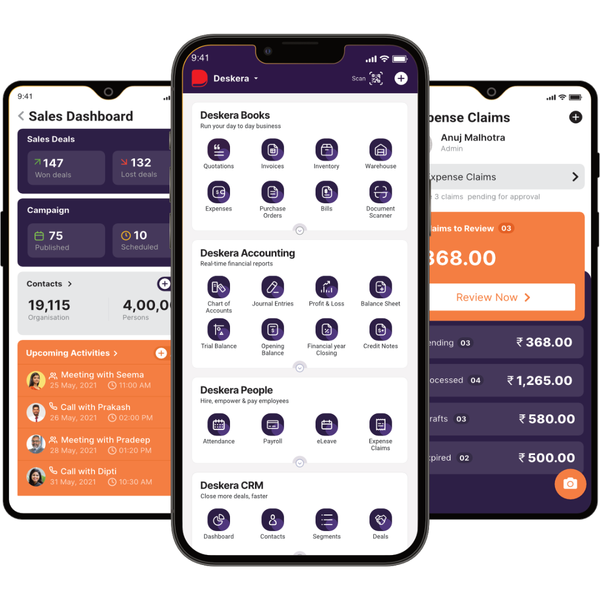Pest Control Manufacturing is a business that specializes in the production and distribution of products used to eliminate or prevent pests from entering homes, businesses, and other areas.

This article covers the following:
- Introduction to Pest Control Manufacturing Budgets
- Understanding the Budgeting Process
- How to make the most of your Pest Control Manufacturing Budget?
- How can Deskera assist you?
Introduction to Pest Control Manufacturing Budgets
Pest control manufacturing budgets are an important consideration for businesses that deal with pests, such as restaurants, hotels, and other hospitality businesses. In order to ensure the safety of customers and employees, it is important to have a budget in place for the purchase and maintenance of pest control products and services.
This type of budget should cover the cost of equipment, materials, chemicals, inspections, and labor needed to keep pests away from the premises. A budget for pest control manufacturing also helps businesses plan for any emergencies that may arise, such as an infestation of pests that requires immediate action.
Pest control manufacturing budgets typically vary from business to business. The size of a business, the type of pests it deals with, and the risk posed by them all factor into the budget.
For example, a hotel may need to consider the cost of treatment for bedbugs, while a restaurant may need to consider the cost of treatment for rodents or cockroaches. The budget should also consider the costs associated with inspections and follow-up services, such as fumigation or baiting.
In order to create an effective pest control manufacturing budget, it is important to consider the different types of pest control products and services that are available. There are a variety of products and services that businesses can use to control pests, such as traps, baits, and sprays.
The budget should also include the costs associated with the inspection and treatment of pests, as well as the cost of any necessary equipment. In addition, the budget should consider any additional services that may be needed, such as fumigation or pest control specialists.
Once the budget has been established, businesses should track their spending to ensure that they are staying within the budget. This can be done by tracking the costs associated with each product or service, as well as the number of treatments that are needed.
This information can then be used to create a long-term plan for pest control manufacturing. Finally, businesses should take into consideration the environmental impact of their pest control manufacturing budget.
Pest control products and services can have a negative impact on the environment if used in excess or without proper care. Businesses should be aware of the potential environmental risks associated with their pest control manufacturing budget and adjust their budget accordingly.
Creating a budget for pest control manufacturing is an important part of ensuring the safety of customers and employees. By researching the different products and services available, tracking spending, and considering the environmental impact, businesses can create an effective and safe pest control manufacturing budget.
Budgeting Process in Pest Control Manufacturing
When it comes to pest control manufacturing, budgeting is an important part of the process. A budget serves as a roadmap for the business, providing guidance on how much money should be allocated for each line item, such as materials, labor, and marketing.
It also helps ensure that the business adheres to its goals and objectives and keeps the company on track financially. Proper budgeting can lead to increased profits and a more efficient use of resources.
The first step in creating a budget for pest control manufacturing is to identify the company’s goals and objectives. This will help determine the amount of money that needs to be allocated to each line item and will help set the parameters for the budget.
Once the goals and objectives have been determined, the business should review its current financial situation to determine its current financial position. This includes reviewing the income statement and balance sheet to determine the company’s overall financial health.
The next step in the budgeting process is to identify any potential expenses that could arise in the future. This includes forecasting the costs of raw materials, labor, utilities, marketing, and other expenses that may be associated with the production of the products.
It is important to consider potential risks and plan for them accordingly. Once the expenses have been identified, the budget can be adjusted accordingly. Once the budget has been developed, it is important to review it regularly to ensure that it is still in line with the company’s goals and objectives.
Additionally, it should be adjusted as needed to account for any changes in the market or the company’s financial situation. When budgeting for pest control manufacturing, it is also important to consider the cost of quality control. Quality control is essential for ensuring that the products are of the highest quality and are safe for the public.
Quality control should be conducted on a regular basis and should include regular inspections and testing of the products. This can help to ensure that the products are of the highest quality and are safe for the public. Finally, when budgeting for pest control manufacturing, it is important to set aside money for research and development.
This money can be used to develop new products or to improve existing products. Research and development can help to ensure that the products are of the highest quality and are safe for the public. Budgeting for pest control manufacturing is an important part of the overall process.
It can help to ensure that the company’s goals and objectives are met and that the company is on track financially. Proper budgeting can lead to increased profits and a more efficient use of resources.
By following the steps outlined above, businesses can create an effective budget for their pest control manufacturing business and ensure that their products are of the highest quality and are safe for the public.
How to Make the Most of the Pest Control Manufacturing Budget?
If you are a pest control manufacturer, you know that having an effective manufacturing budget is essential to success. Whether you are a large or small business, it is important to make the most of your budget to ensure that you can produce quality products while still making a profit. Here are some tips to help you get the most out of your pest control manufacturing budget.
Utilize Automation
Automating certain processes in your manufacturing process will help you save time and money. Automating tasks such as packaging, labeling, and other production steps can help you streamline the manufacturing process and save money. Automation also helps to reduce the risk of human error, which can cost you time and money in the long run.
Invest in Quality Materials
Investing in quality materials is essential to producing quality pest control products. Low-quality materials may be cheaper in the short term, but they can lead to costly errors and repairs in the long run. Investing in quality materials will help you produce higher-quality products that will last longer and have a better return on investment.
Outsource When Necessary
Outsourcing certain production tasks can save you time and money. For example, if you are having trouble finding a specific type of material or tool, outsourcing the task to a professional can save you time and money. Outsourcing can also help you find cost-effective solutions to production problems that you may not have considered.
Utilize New Technology
Technology is changing the way we do business, and the pest control industry is no exception. Investing in the latest technology can help you streamline the production process and reduce costs. For example, if you are producing an insecticide, investing in a robotic sprayer can help you produce more products with fewer resources.
Negotiate Prices
When it comes to purchasing materials, you should always try to negotiate. By bargaining with suppliers, you can often get more bang for your buck. Don’t be afraid to haggle with suppliers in order to get the best possible price.
By following these tips, you can make the most of your pest control manufacturing budget. By investing in quality materials, utilizing automation and new technology, and negotiating prices, you can save time and money while still producing quality products.
How Can Deskera Assist You?
As a manufacturer, you must keep track of your inventory stock. The condition of your inventory has a direct impact on production planning. It also has a direct impact on people and machinery use and capacity utilization.

Deskera MRP is the one tool that lets you do all of the above. With Deskera, you can:
- Control production schedules
- Compile a Bill of Materials
- Produce thorough reports
- Make your dashboard
Deskera ERP is a complete solution that allows you to manage suppliers and track supply chain activity in real time. It also allows you to streamline a range of other company functions.
Deskera Books allows you to manage your accounts and finances better. It helps maintain good accounting standards by automating billing, invoicing, and payment processing tasks.
Deskera CRM is a powerful tool that organizes your sales and helps you close deals rapidly. It enables you to perform crucial tasks like lead generation via email and gives you a comprehensive view of your sales funnel.
Deskera People is a straightforward application for centralizing your human resource management activities. Not only does the technology expedite payroll processing, but it also helps you to handle all other operations such as overtime, benefits, bonuses, training programs, and much more.
Key Takeaways:
- In order to ensure the safety of customers and employees, it is important to have a budget in place for the purchase and maintenance of pest control products and services.
- Pest control manufacturing budgets typically vary from business to business.
- The size of a business, the type of pests it deals with, and the risk posed by them all factor into the budget.
- The budget should also include the costs associated with the inspection and treatment of pests, as well as the cost of any necessary equipment.
- Once the budget has been established, businesses should track their spending to ensure that they are staying within the budget
Related Articles:













